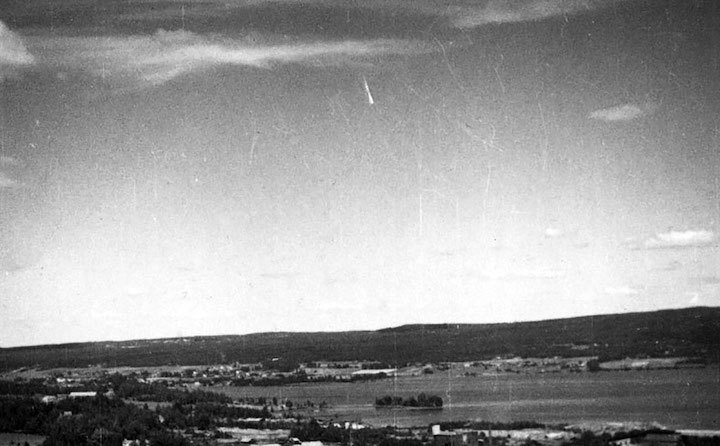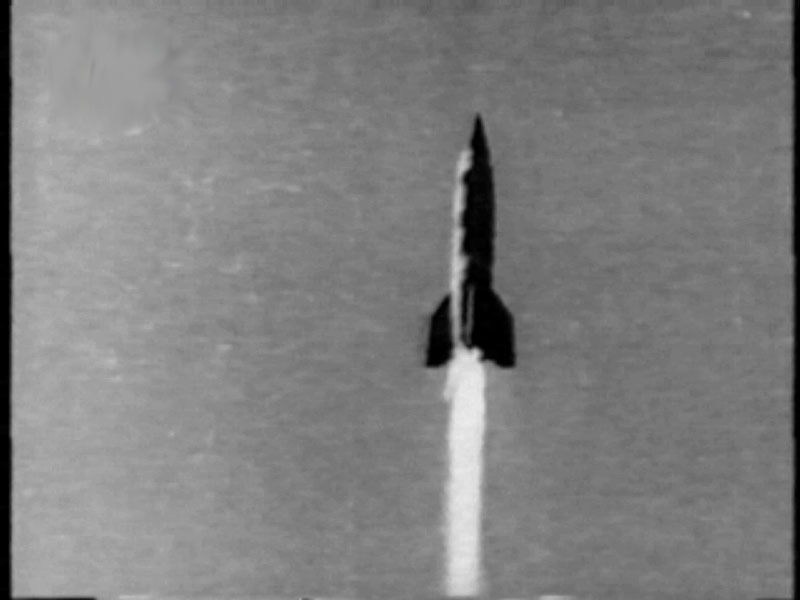20.05.2020

The Swedish Ghost Rockets

It began in early 1946 with a report out of Finland of something streaking across the sky at a high altitude. Soon more stories came in of similar sightings from Norway, and even more from Sweden. 1946 had become the year of what we now call the Swedish ghost rockets, unexplained bright objects moving across the sky, during both the day and night, frightening and confusing eyewitnesses. Some say fragments were recovered, and others say the objects were tracked on Swedish Air Force radar. At least one was said to have crashed into a lake, though nothing was ever found. Today we're going to follow the history of this story, and see if we can solve what might have been in the sky that resulted in today's popular UFO legend.
Reports of the number of ghost rocket sightings range from a few hundred to two thousand, and reports of radar traces from zero to two hundred — though given that radar was still in its infancy in 1946, we can't responsibly claim to learn much from that. The difficulty in estimating the scope of the phenomenon comes from the fact that there was no central logging of reports at the time, and the numbers we have today come from authors — more often than not, UFO authors who tend to take an exaggerated or sensationalist perspective — making estimates based on adding up the claims from previous authors and contemporary reports. So, in fact, there is no reliable estimate of how many individual ghost rockets were seen. From surveying all the literature, though, it does seem clear that it was a relatively large number, at least in the dozens and possibly in the hundreds, spread over the year 1946, peaking in mid-August. Despite all this apparent activity, there is only one known photograph — it's the one you see on Wikipedia and elsewhere online. It's a white streak up in the sky, which could be anything.
At the height of the phenomenon, the United States sent two men — retired Army Air Force General Jimmy Doolittle (an oil executive) and reserve Signal Corps General David Sarnoff (a telecommunications executive) — to Stockholm to see what they could find out. Whatever they were, the ghost rockets were being taken very seriously.
Perhaps the most often cited conventional explanation for the ghost rocket phenomenon has been test firings of Soviet missiles developed from captured German V-2 rockets. The timing is perfect; in mid 1946, the Soviets did have an active program developing the missiles. It was headquartered at Mittelwerk near Nordhausen in Germany, which had been the Nazis' primary V-2 factory, and was hard at work reproducing them from leftover German parts as fast as they could. Test launches from there would likely have headed north toward the North Sea, to pass over Oslo, on what's basically the exact path that modern accounts claim the ghost rockets took.
Soviet engineers had taken possession of the plant in July 1945, which only two months before, had been churning out an incredible 35 V-2s per day using slave labor. The Soviets' goal was to restore V-2 production, and achieve up to 30 test launches per day. In October 1946, just over a year after their arrival — a year which incorporated the time frame of the ghost rockets — the Soviets closed the plant in Germany and moved their entire V-2 program to a new facility near Moscow. Given these facts, it sounds like Soviet V-2 test launches in the summer of 1946 are a dead ringer for the ghost rocket reports.
From the beginning, that the ghost rockets were Soviet-launched missiles developed from German V-2s was the default assumption in the world press. As early as February 1946, the French science magazine Science et Vie ran a cover showing an artist's impression of the R-1 (the Soviets' name for their uprated V-2) blasting through the skies above northern Europe. In the United States, Collier's magazine said:
Scandinavian countries have reported mysterious rockets and lights knifing their skies... They are Russian stepchildren of the V-1, which devastated London. But instead of a range of 160 miles, these have a range that carries them across the Pole — from Europe to a target area in Siberia.
The French newspaper Le Monde said:
Another of these flying bombs has been seen by Lieutenant Lennart Nackman, from the Swedish territorial army staff... According to the experts, the hypothesis of meteors is absolutely excluded.
But this is a tiny sample; both papers, as well as many others, ran numerous articles throughout 1946 reporting many flights of the Soviet rockets over Scandinavia. By the time the phenomenon peaked in August, the hysteria peaked right along with it. The two American generals reported back to President Truman that the V-2s were likely being launched from Peenemünde, a former German V-2 base now in the hands of the Soviets, and right on the Baltic Sea.

However, there's a detail that's worth mentioning at this point in our story. The Soviets never launched a single V-2 rocket in 1946 from anywhere. After the dissolution of the Soviet Union in 1991, historical sources became available that gave us a complete history of the space race from the Soviet perspective, and we now know for a fact that V-2 rockets, or any derivatives of them, could not have accounted for the Swedish ghost rockets. As World War II had come to a close and all the Allied powers raced to secure the German rocket technology for themselves, several factors worked against the Soviets. Most importantly, Werner von Braun and virtually all of the key German scientists had made plans well in advance — as early as January of 1945 — to surrender to Americans rather than to Soviets, as it was well known within the German military that capture by Soviets meant the Gulags. In addition, the Americans got to the German V-2 factories first, leaving them thoroughly plundered for the Soviets. The plants at Nordhausen and Peenemünde were described as "75% wreckage", and none of the Germans who remained to be captured had any high level expertise.
Consequently, the Soviets got off to a slow start. By the time they left Germany for Moscow in October 1946, they'd managed to complete only 30 missiles in total, and had launched zero of them — a far cry from the 30 flights a day they were hoping for. But there's no way the Western press reporting evil Soviet rocket launches could have known this, as Nordhausen was inside the newly formed, Soviet controlled East Germany. So they continued pointing the finger, causing frustration to grow inside the Soviet Union.
In September, the Soviet journal New Times declared that the Western press' characterization of the phenomenon as Soviet aggression was merely anti-Soviet slander and propaganda, and this report was passed along in the Western press. It was the first time that this perspective, which had previously been a minority view, was taken seriously. And it gave a new voice to those who had been saying this all along, and had been drowned out in all the noise about V-2s.
Virtually overnight, the tone of reporting changed. Now the New York Times was quoting the Swedish Nobel Prize winner Dr. Manne Siegbahn and other scientists who said there was no evidence at all that Soviet missiles — or any other missiles — had flown over Scandinavia, and even used the term "hysteria" to describe the previous reporting. One quoted scientist said:
I myself examined one reported to be such a missile and found it was a meteorite. I am very suspicious about the existence of any such thing.
The nature of the ghost rockets phenomenon changed again — this time for good — a few months into 1947, when a private pilot in Washington state named Kenneth Arnold saw something unidentified, and it was reported in the press using a brand new term that launched an entire genre: a flying saucer. UFO authors lapped up the word ravenously, and applied it to anything and everything they could, including the Swedish ghost rockets.
From then on, there ceased to be much scholarly writing or research into the phenomenon, and it became relegated almost exclusively to the realm of UFO books. It was almost always described with something of a crackpot tone that presumed the rockets were alien spacecraft, and that they had always been regarded as such from the beginning — a significant rewriting of history.
So what were the Swedish ghost rockets? As is the case with so many stories, the best answer is that we don't know. We do know that the peak of reports from August 9-11 was during the peak of the Perseids meteor shower on August 9-14, so it's a certainty that some of the reports were misidentified shooting stars.

USAF, B-29
We also know that since neither Norway nor Sweden were bombed during WWII (with a very few exceptions), most of the population had never seen high-altitude contrails before, and were unfamiliar with them. However, contrails suddenly began to appear overhead with the rise of postwar air commerce, and with the Americans' new use of high-altitude B-29s for reconnaissance over northern Europe. And we now know for a fact that these contrails were responsible for some percentage of the ghost rocket reports. On August 26, the US Naval Attache in Stockholm issued a memo (Report R334-46), classified Top Secret, speculating on the cause of the ghost rocket reports in Sweden:
Sweden may be experimenting with rockets, but is concealing the fact and encouraging belief that rockets of foreign origin are being launched over Sweden, with civilian observers reporting jet fighters, contrails and meteors as rockets.
And, very importantly, the memo also went on to note:
To date no US military or naval personnel in Sweden have seen any fragments, photographs, radar tracks, points of impact, or other evidence of any kind to prove that guided missiles have actually been seen over Swedish territory.
No fragments, no photographs, no radar tracks, no evidence of any kind.
What was in the sky over Sweden in 1946 were streaking contrails during the day and the peak of a meteor shower during the night. Combined with mass international paranoia over the rise of the Soviet Union and their frightening work on ballistic missiles, scarcely anything else was needed to trigger one of the most famous years in the history of UFOlogy. Might new evidence surface one day proving there was something more to it? Certainly it may; but until it does, the ghost rockets will likely remain mere phantoms.
Quelle: Skeptoid
